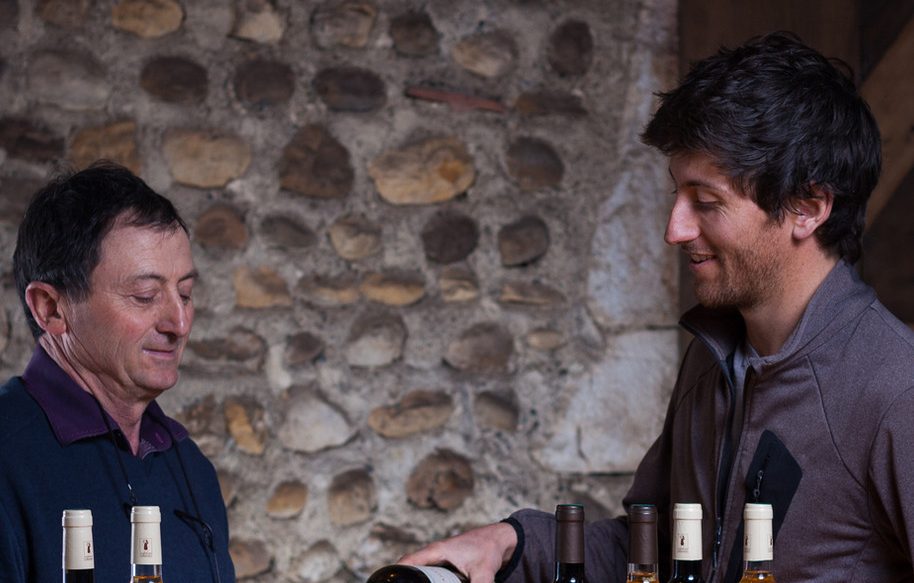



He was baptized with a drop of Jurançon on his lips, as were his father and grandfather before him, and, legend has it, King Henri IV. Whether that early sip of wine has played its role or not Franck Lihour is today counted as one of the pinnacle producers in the region.
Dating back to the 18th century, purchased by Francks great-great- grandfather in 1895, Domaine Castéra has a tremendously rich history. At the time, it was a simple farm built on a few hectares of vineyards, crops and pastures for grazing cattle. Tradition has continued through generations and has transformed Castéra to the charismatic winery it is today.
When Franck grew up, seeing his parents work the vineyards, it surely inspired him to pursue a career in winemaking. He studied viticulture and oenology in Bordeaux and gained experience working abroad, across both the old and new world of wine, with additional studies on indigenous grape varieties at a research center on Corsica. Close to his 30’s he felt eagerly ready to return to the family basis. Still counted in to the herd of young winemakers Franck has in a short period of time lifted his family’s estate into next-level greatness with his energizing wines.
Jurançon, in the southwest corner of the country, is affected by both the Atlantic Ocean and the Pyrenees, resulting in a warm, humid and oceanic climate with mountain influence. The area’s humidity is notable,
and cloudy weather often brings rain. It covers around 1300 hectares, but they are dispersed due to the region’s dedication to polyculture.
The majority of the wine is made by farmers who own less than two hectares of vines and sell their grapes to cooperatives.
The appellation is almost solely and brilliantly devoted to the Manseng family – Gros and Petit. Despite their shared name and long history they are surprisingly different from each other according to Franck. He questions whether they are truly related at all, as they have distinct differences. In Jurançon, great dry white wines are a recent development according to Franck, who attributes the change to a shift in vineyard practices. In the past, vineyards in the region had a low density of vines, which led to large quantities of bunches per vine and varying maturity levels. However, by increasing the density growers have been able to produce higher-quality grapes, resulting in better wines that are now attracting well deserved attention.
Vineyards are planted on steep slopes. Located in northeastern part of the appellation the underlying rock is primarily made up of a deep layer, up to 300 meters in depth, of Poudingue de Jurançon. Poudingue, a type of rock, gets its name from the English word ‘pudding’ due to its resemblance to a fruit pudding. It is a conglomerate rock composed of at least 50% alluvial gravels and cobbles, held together by limestone.
The alluvial gravels and cobbles make up the ”fruit” while the limestone acts as the ”batter”. Its loose cementation allows for easy weathering and erosion.
Franck started the process of transitioning his vineyards to organic upon his return in 2014 (going biodynamic). The shift was always definite, but never easy. The regions large amount of rain makes the grass grow rapidly and thick, and the disease pressure is strong. “Basically, if you fall behind you’re dead”, he describe. Gros and Petit Manseng dominate the vineyards with addition of old local Petit Courbu and Camaralet. The production is scattered over 15 sub-terroirs based on vine age, altitude, variety and are devoted either to dry or sweet wine. This allows for a highly specific and nuanced winemaking process that showcases the unique characteristics of each address.
Every parcel is vilified separately, gently presses whole clusters for several hours without addition of sulfur. The juice is allowed to brown heavily, following the Champagne model with separate vinification for cuvée and tailles. The tailles are vilified separately, with a lot more oxygenation to precipitate phenolics. They are later blended back in. Aging takes place in used barrels, demi-muids and stainless steel. For sweet wine selected terroirs are used through passerillage, rather than botrytis, resulting in desiccated grapes. However, this does not entail a later harvest, as these terroirs tend to ripen early. Vinification remains the same as for dry wines, addition of tiny amounts of sulphur is added when he feels it necessary.
Franck is increasingly refining what is possible in an otherwise forgotten appellation. With quality driven focus and precision he’s positioned to continue producing exceptional reference wines for years to come.